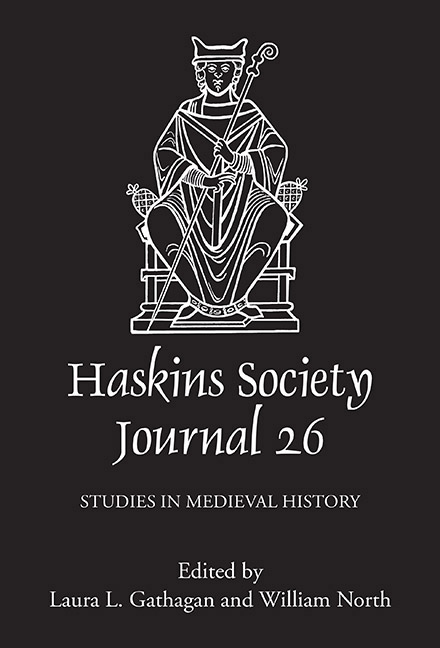Book contents
- Frontmatter
- Contents
- List of Figures
- Editors’ Note
- Abbreviations
- 1 Mores Tuos Fabricae Loquuntur Building Activity and the Rhetoric of Power in Ostrogothic Italy
- 2 A Hermeneutical Feast: Interreligious Dining in Early Medieval Conciliar Legislation
- 3 A Hypothetical Slave in Constantinople: Amalarius’s Liber Officialis and the Mediterranean Slave Trade
- 4 Welsh Kings at Anglo-Saxon Royal Assemblies (928–55)
- 5 The Diplomatics of Depredation: Reconsidering Holy Trinity Caen’s List of Losses
- 6 When Did Robert of Torigni First Receive Henry of Huntingdon’s Historia Anglorum, and Why Does It Matter?
- 7 A Coin Bearing Testimony to Duchess Matilda as Consors Regni
- 8 Fighting to be the Tallest Dwarf: Invidia and Competition in the Self-Conception of Eleventh- and Twelfth-Century Masters
- 9 Brut y Tywysogion: the History of the Princes and Twelfth-Century Cambro-Latin Historical Writing
- 10 The Use of English Annalistic Sources in Medieval Welsh Chronicles
- 11 A Franco-Danish Marriage and the Plot against England
7 - A Coin Bearing Testimony to Duchess Matilda as Consors Regni
Published online by Cambridge University Press: 25 May 2021
- Frontmatter
- Contents
- List of Figures
- Editors’ Note
- Abbreviations
- 1 Mores Tuos Fabricae Loquuntur Building Activity and the Rhetoric of Power in Ostrogothic Italy
- 2 A Hermeneutical Feast: Interreligious Dining in Early Medieval Conciliar Legislation
- 3 A Hypothetical Slave in Constantinople: Amalarius’s Liber Officialis and the Mediterranean Slave Trade
- 4 Welsh Kings at Anglo-Saxon Royal Assemblies (928–55)
- 5 The Diplomatics of Depredation: Reconsidering Holy Trinity Caen’s List of Losses
- 6 When Did Robert of Torigni First Receive Henry of Huntingdon’s Historia Anglorum, and Why Does It Matter?
- 7 A Coin Bearing Testimony to Duchess Matilda as Consors Regni
- 8 Fighting to be the Tallest Dwarf: Invidia and Competition in the Self-Conception of Eleventh- and Twelfth-Century Masters
- 9 Brut y Tywysogion: the History of the Princes and Twelfth-Century Cambro-Latin Historical Writing
- 10 The Use of English Annalistic Sources in Medieval Welsh Chronicles
- 11 A Franco-Danish Marriage and the Plot against England
Summary
In January 1168 Matilda (b. 1156–d. 1189), the twelve-year-old daughter of Henry II of England and Eleanor of Aquitaine, arrived in Saxony. A charter, issued at Minden, attests that on the first of February at Minden she was engaged to Duke Henry the Lion (b. 1133/35–d. 1195). Although many chroniclers relate that Henry and Matilda were married, specific information on their wedding is scarce. Whilst giving an overview of events occurring around 1168 in his Annales Stadenses (1240–56), Albert of Stade writes that the wedding feast (nuptias) in Brunswick was celebrated in great splendour. This is the only relatively contemporary reference to their wedding and, together with the aforementioned charter, it has been taken as evidence that Henry and Matilda celebrated their wedding in that year. According to the numismatist Julius Menadier, the ducal couple festively distributed coins among the people on arrival at the Brunswick residence. He based this idea on the existence of bracteates (thin silver coins struck on one side) that depict the busts of Henry and Matilda, each of them holding a sceptre, which he believed were wedding coins issued in 1168 (Fig. 1). Menadier's theory is often given the weight of fact. The issuance of a wedding coin would be plausible since Henry and Matilda's marriage was politically significant and involved several important parties. One can therefore imagine that the wedding was celebrated abundantly, and might have included the distribution of coins. But if Menadier is correct, the sceptre in Mathilda's hand was a meaningless iconographical trope. Mathilda was a young woman who had just married a man three times her age. Her first four years in her new home were not indeed marked by an active assertion of her authority. This would come four years later when Henry departed on crusade, leaving his wife, now older and more established, equipped to hold authority in his stead if necessary. It was this occasion, I would argue, that motivated the creation and distribution of a new bracteate, featuring Matilda wielding a sceptre, the traditional attribute of rule, as a consors regni or co-ruler with her husband.
- Type
- Chapter
- Information
- The Haskins Society Journal 262014. Studies in Medieval History, pp. 169 - 190Publisher: Boydell & BrewerPrint publication year: 2015
- 1
- Cited by

